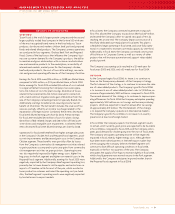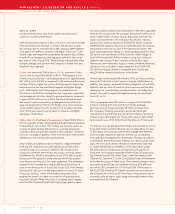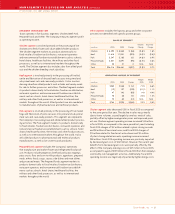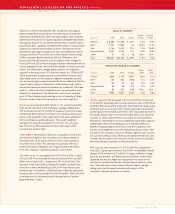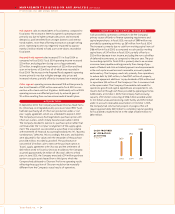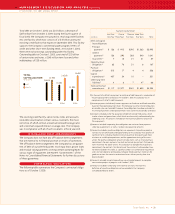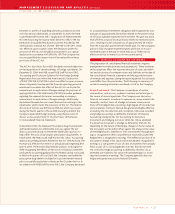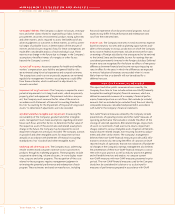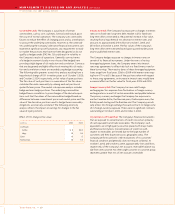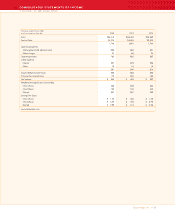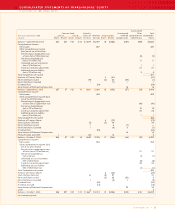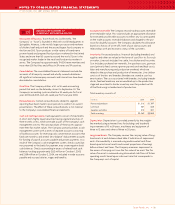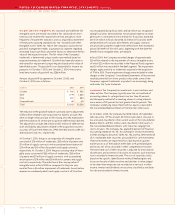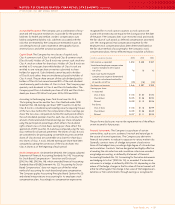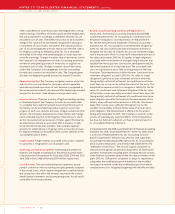Tyson Foods 2005 Annual Report Download - page 30
Download and view the complete annual report
Please find page 30 of the 2005 Tyson Foods annual report below. You can navigate through the pages in the report by either clicking on the pages listed below, or by using the keyword search tool below to find specific information within the annual report.
>> MANAGEMENT’S DISCUSSION AND ANALYSIS (CONTINUED)
TYSON FOODS, INC. 2005 ANNUAL REPORT
Tyson Foods, Inc. >> 28
Contingent liabilities: The Company is subject to lawsuits, investiga-
tions and other claims related to wage and hour/labor, livestock
procurement, securities, environmental, product, taxing authorities
and other matters, and is required to assess the likelihood of any
adverse judgments or outcomes to these matters, as well as poten-
tial ranges of probable losses. A determination of the amount of
reserves and disclosures required, if any, for these contingencies are
made after considerable analysis of each individual issue. These
reserves may change in the future due to changes in the Company’s
assumptions, the effectiveness of strategies or other factors
beyond the Company’s control.
Accrued self insurance: Insurance expense for health and welfare,
workers’ compensation, auto liability and general liability risks
are estimated using historical experience and actuarial estimates.
The assumptions used to arrive at periodic expenses are reviewed
regularly by management. However, actual expenses could differ
from these estimates, which could result in adjustments to
amounts recorded.
Impairment of long-lived assets: The Company is required to assess
potential impairments to its long-lived assets, which are primarily
property, plant and equipment. If impairment indicators are pres-
ent, the Company must measure the fair value of the assets in
accordance with Statement of Financial Accounting Standards
No. 144, “Accounting for the Impairment of Disposal of Long-Lived
Assets,” to determine if adjustments are to be recorded.
Goodwill and other intangible asset impairment: In assessing the
recoverability of the Company’s goodwill and other intangible
assets, management must make assumptions regarding estimated
future cash flows and other factors to determine the fair value of
the respective assets. If these estimates and related assumptions
change in the future, the Company may be required to record
impairment charges not previously recorded. The Company assesses
its goodwill and other intangible assets for impairment at least
annually in accordance with Statement of Financial Accounting
Standards No. 142, “Goodwill and Other Intangible Assets.”
Marketing and advertising costs: The Company incurs advertising,
retailer incentive and consumer incentive costs to promote its
products through its marketing programs. These programs include
cooperative advertising, volume discounts, in-store display incen-
tives, coupons and other programs. The recognition of the costs
related to these programs requires management judgment in
estimating the potential performance and redemption of each
program. These estimates are based on many factors, including
historical experience of similar promotional programs. Actual
expenses may differ if the performance and redemption rates
vary from the estimated rates.
Income taxes: The Company estimates its total income tax expense
based on statutory tax rates and tax planning opportunities avail-
able to the Company in various jurisdictions in which the Company
earns income. Federal income taxes include an estimate for taxes
on earnings of foreign subsidiaries that are expected to be remitted
to the United States and be taxable, but not for earnings that are
considered permanently invested in the foreign subsidiary. Deferred
income taxes are recognized for the future tax effects of temporary
differences between financial and income tax reporting using tax
rates in effect for the years in which the differences are expected
to reverse. Valuation allowances are recorded when it is more
likely than not that a tax benefit will not be realized for a
deferred tax asset.
NON-GAAP FINANCIAL MEASURES
This report and other public communications issued by the
Company from time to time include certain non-GAAP (Generally
Accepted Accounting Principles) financial measures, which are
defined as numerical measures of a company’s financial perfor-
mance, financial position or cash flows that exclude (or include)
amounts that are included in (or excluded from) the most directly
comparable measures calculated and presented in accordance
with GAAP in the Company’s financial statements.
Non-GAAP financial measures utilized by the Company include
presentations of operating income and other GAAP measures of
operating performance that exclude or include the effect of the
closings of selected operations, BSE-related charges, dispositions
of assets or investments, fixed asset write-downs, impairment
charges related to various intangible assets, litigation settlements,
natural disaster related charges, non-recurring income tax adjust-
ments and other similar events. The Company’s management
believes these non-GAAP financial measures provide useful infor-
mation to investors by removing the effect of variances in GAAP
reported results of operations that are not indicative of fundamen-
tal changes in the Company’s earnings. Management also believes
the presentation of these non-GAAP financial measures is consis-
tent with its past practice, as well as industry practice in general,
and will enable investors and analysts to compare current
non-GAAP measures with non-GAAP measures presented in prior
periods. The non-GAAP financial measures used by the Company
should not be considered in isolation or as a substitute for
measures of performance prepared in accordance with GAAP.



